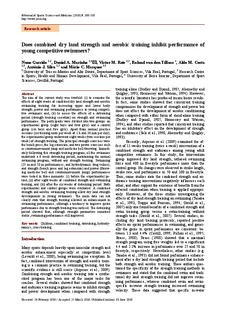Does combined dry land strength and aerobic training inhibit performance of young competitive swimmers?
Tillaar, Roland J. Wilhelmus Van Den; Garrido, Nuno; Marinho, Daniel; Reis, V; Costa, Aldo; Silva, Jose Antonio; Marques, Mario
Journal article, Peer reviewed
Permanent lenke
http://hdl.handle.net/11250/149353Utgivelsesdato
2010Metadata
Vis full innførselSamlinger
Originalversjon
Tillaar, R. J. W. v.den (2010): Does combined dry land strength and aerobic training inhibit performance of young competitive swimmers? Journal of sports science & medicine, 9(1), 300-310.Sammendrag
The aim of the current study was twofold: (i) to examine the
effects of eight weeks of combined dry land strength and aerobic
swimming training for increasing upper and lower body
strength, power and swimming performance in young competitive
swimmers and, (ii) to assess the effects of a detraining
period (strength training cessation) on strength and swimming
performance. The participants were divided into two groups: an
experimental group (eight boys and four girls) and a control
group (six boys and five girls). Apart from normal practice
sessions (six training units per week of 1 h and 30 min per day),
the experimental group underwent eight weeks (two sessions per
week) of strength training. The principal strength exercises were
the bench press, the leg extension, and two power exercises such
as countermovement jump and medicine ball throwing. Immediately
following this strength training program, all the swimmers
undertook a 6 week detraining period, maintaining the normal
swimming program, without any strength training. Swimming
(25 m and 50 m performances, and hydrodynamic drag values),
and strength (bench press and leg extension) and power (throwing
medicine ball and countermovement jump) performances
were tested in three moments: (i) before the experimental period,
(ii) after eight weeks of combined strength and swimming
training, and (iii) after the six weeks of detraining period. Both
experimental and control groups were evaluated. A combined
strength and aerobic swimming training allow dry land strength
developments in young swimmers. The main data can not
clearly state that strength training allowed an enhancement in
swimming performance, although a tendency to improve sprint
performance due to strength training was noticed. The detraining
period showed that, although strength parameters remained
stable, swimming performance still improved.
Beskrivelse
Reprinted from Journal of Sports Science & Medicine, Vol. 9, Tillaar, Roland J. Wilhelmus Van Den, Garrido, Nuno, Marinho, Daniel, Reis, V, Costa, Aldo, Silva, Jose Antonio, Marques, Mario, Does combined dry land strength and aerobic training inhibit performance of young competitive swimmers?, pp 300-310, 2010, with permission from the JOURNAL OF SPORTS SCIENCE AND MEDICINE.
